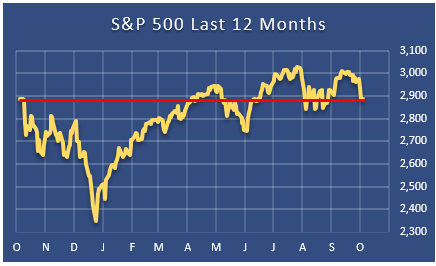In the Realm of Investing, Does 1+1 Always Equal 2? Not by a Long Shot.
As of today, the stock market is about where it was 12 months ago. (See chart below.) The year-over-year return is -0.5%. That’s about as close to “flat” as the market gets over any 12 month period.
Now suppose that over the remaining 3 months of 2019 the market zigs and zags but comes to rest right where it is today. What can we say, arithmetically speaking, about the performance of the market in 2019?
The easy answer is that the market notched a small loss of -0.5%, the same as it is today. But is this correct? No. And here’s why.
On December 31st, 2019, the market will indeed be at the same price that it is today. There will be no further gains or losses for the next 3 months. But due to the quirky nature of math, the market will have ended the year with a gain of 15.2%!
How is that possible when the market went nowhere during the last 3 months of the year? The answer is revealed by simple arithmetic.
It all comes down to one simple idea
In the chart above, the time frame is 12 months – October 2018 to October 2019. When we fast-forward to the end of 2019 the same time 12 month frame is used, but the starting point changes. This is the key that unlocks the puzzle.
Instead of using October 4th, 2018 as the starting point, we will be using December 31st, 2018. So, the ending price is the same, but the starting price is much lower, which accounts for the 15.2% year-over-year gain in a seemingly flat market.
Math nerds will easily grasp the concept of this problem, but non-nerds may find it hard to wrap their heads around.
Not for nothing
Why do I think this little exercise is meaningful? Because it demonstrates just how easy it is to manipulate stock market data. If a purveyor of a mutual fund or a trading system wants to put a happy face on their dismal track record, all they need to do is play around with the starting point of their calculations, and BAM! A lousy record becomes a great one.
There are rules and conventions in place to prevent this kind of data manipulation, but they are easy to get around. So, pay close attention to marketing pitches that seem too good to be true.
The Madoff Scam
Bernie Madoff was so clever that he instinctively knew to avoid publishing abnormally high return numbers, choosing instead to present numbers that were above average and consistent, regardless of what the market was doing. That’s how he was able to get away with his scam for 20 years and rake in a profit of $50 billion.
I’m not saying that there are other Bernie Madoffs out there. I’m just saying that performance numbers are easy to manipulate. My suggestion is to look at any published track record from many different time frames, not just the one that is being highlighted by the seller.
The Gatekeepers
Organizations like Morningstar, Motley Fool, and Hulbert hold themselves out as arbiters of performance and trustworthiness in a marketplace that’s rife with posers, pirates and charlatans. These gatekeepers have rating schemes and quality hurdles that are intended to give the impression that there is someone out there who is looking out for us. I urge caution.
By its own admission, Morningstar downplays the usefulness of their star ratings. Good on them for being honest. Other rating agencies and organizations are not inclined to advertise their limitations.
Remember the global financial crisis of 2008? It was created, in part, by credit rating agencies like Standard & Poors, Moodys, and Fitch. These gatekeepers were supposed to warn investors about trouble, but they failed to do so.
Instead, they sided with the creators of all that toxic paper and nearly broke the global financial system. Could this happen again? As long as the gatekeepers get paid by issuers of debt and equity, the answer is yes.
It all comes down to simple math
I’ve shown you how easy it is to fool people into believing that a losing investment idea is really a winning one, and you should get on board before the train leaves the station. And I’ve shown how even the most highly respected gatekeepers can be corrupted by the allure of easy money from the people who fund their efforts.
The antidote to this nonsense is simple math. You decide what the starting date is. You decide whether the investment scheme makes sense. You decide whether the performance numbers are credible or not. It’s all up to you, because there are no real gatekeepers.

